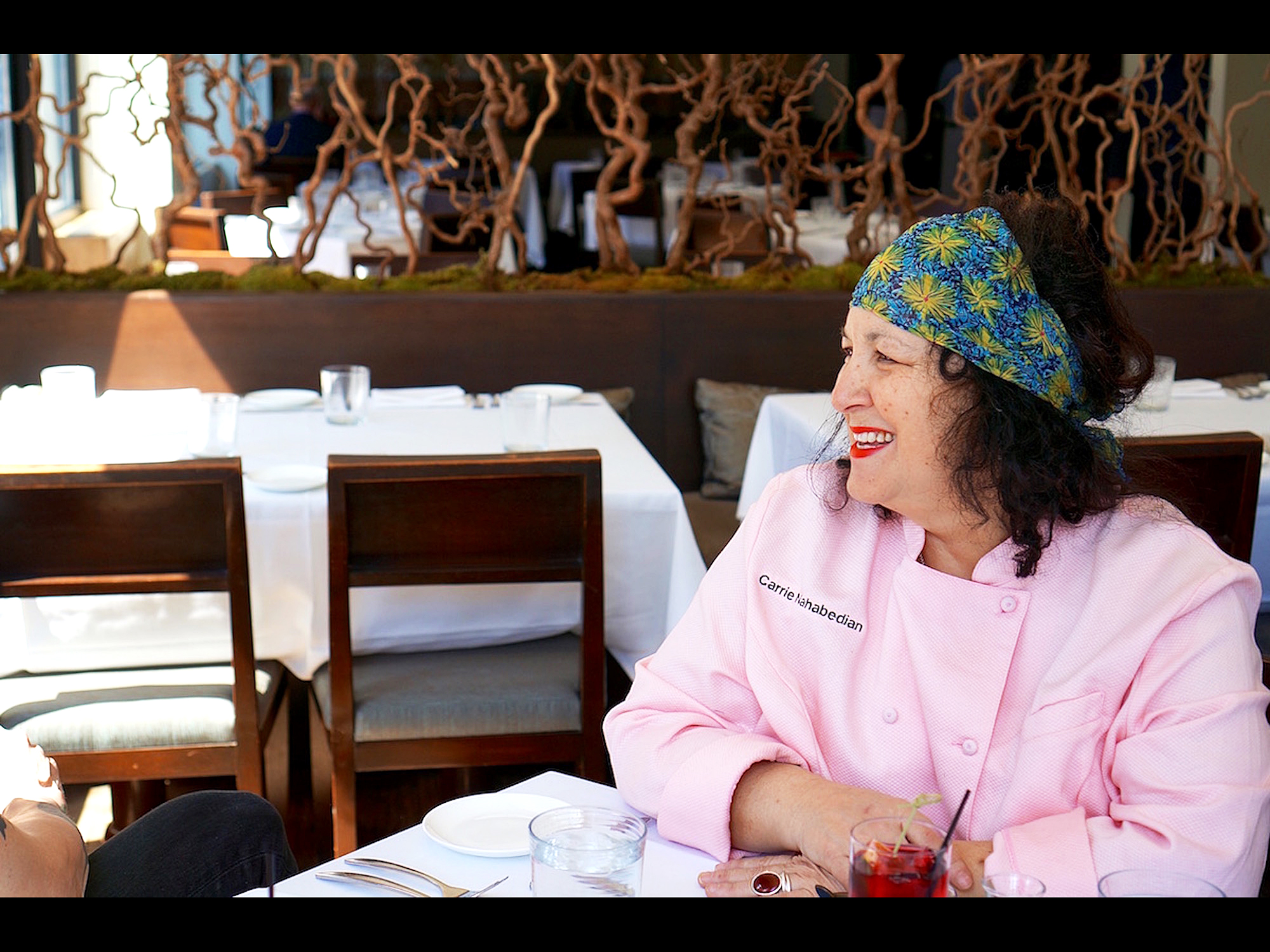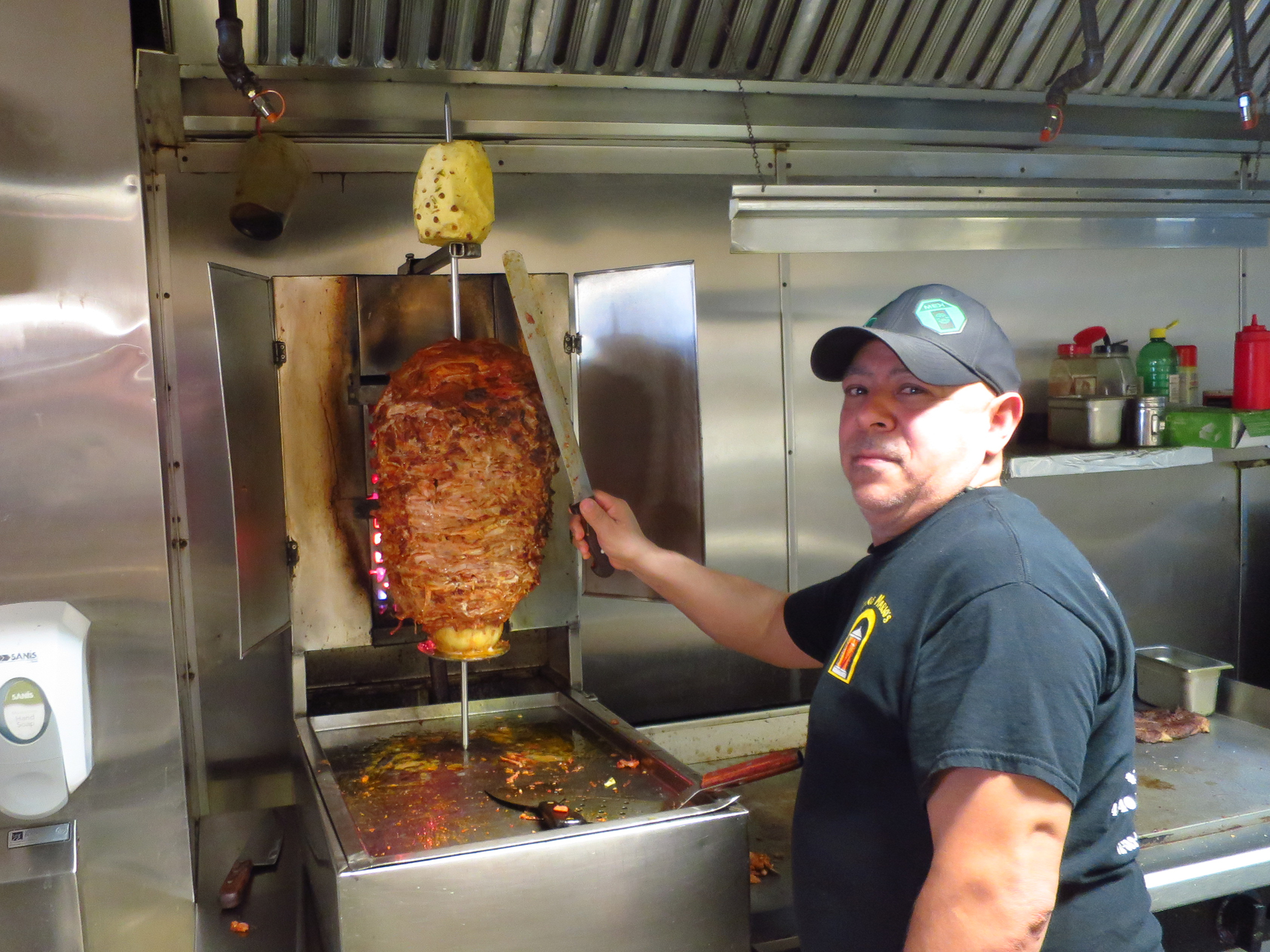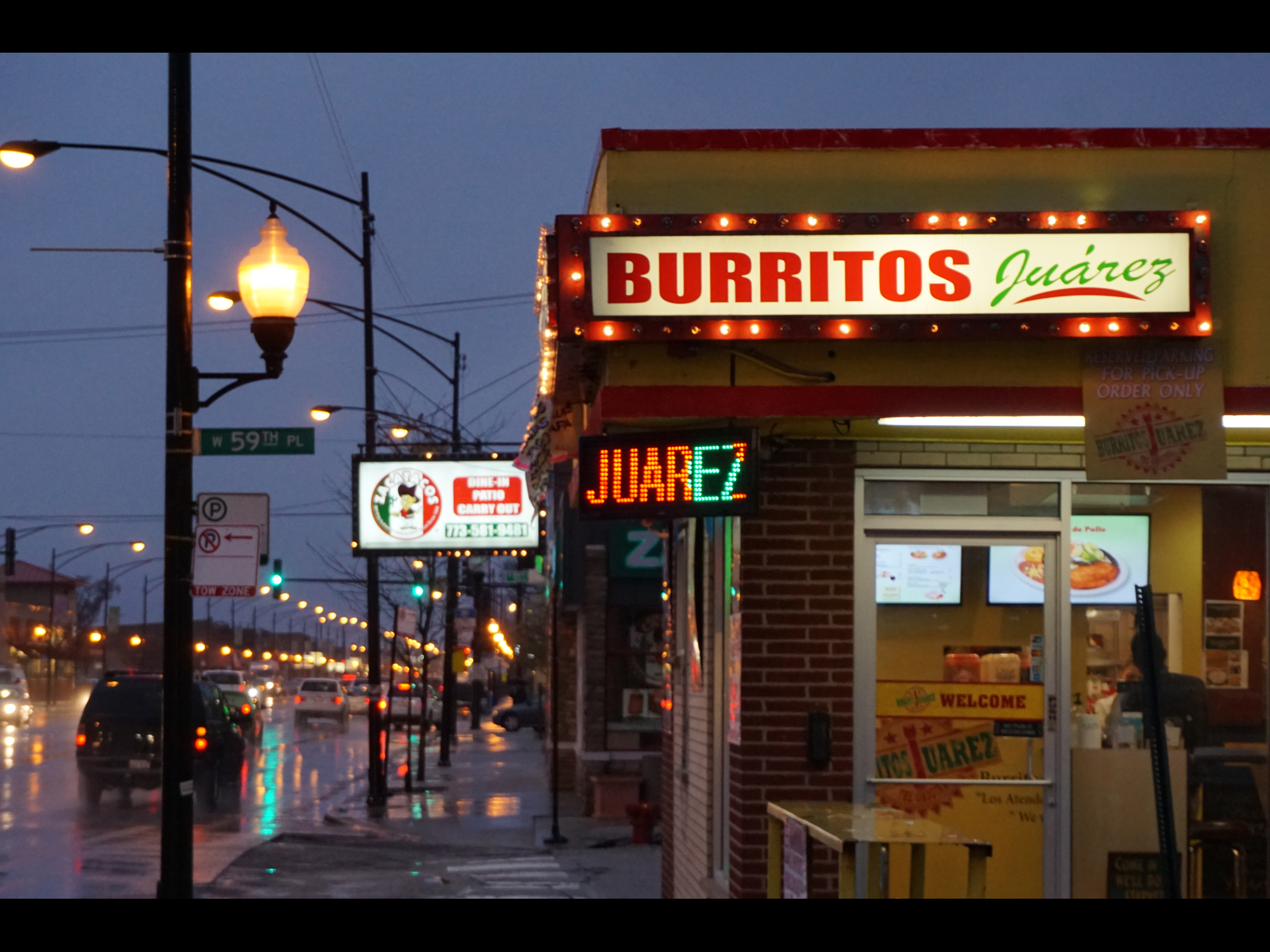AN OLD KFC TRICKED OUT IN BOB MARLEY COLORS—that might be your first reaction to Tortilleria y Taqueria Los Gamas, a taco restaurant inside a former KFC on Armitage near the mostly Mexican southwestern edge of Logan Square. (Actually, they’re the state colors of Guerrero, yellow, red and green.) The first thing you’ll see upon entering it is a Bible verse painted on the wall in English. The first thing you smell is, without a doubt, tortillas—specifically the masa that is used to make them, the unmistakable combination of corn, soap and enough steam for a sauna.
If it’s lunchtime you’ll also smell how they’re putting the masa to use making tacos, and many people will stop there. A couple of ladies who just have enough English to take your order stand next to a grill, patting out sopes and frying up tacos which are solid, well-made examples of their type. Even better, if you ask me, there might be a special lunch or two, like the chicken in mole rojo one day, which made my mouth glow happily with heat (and did the same for my son when I took it home and he polished it off that night), accompanied by a couple of fresh tortillas warm as your mom tucking you in. Tacos are fast food; something like that is a true Mexican meal, an authentic comida, and hugely satisfying.
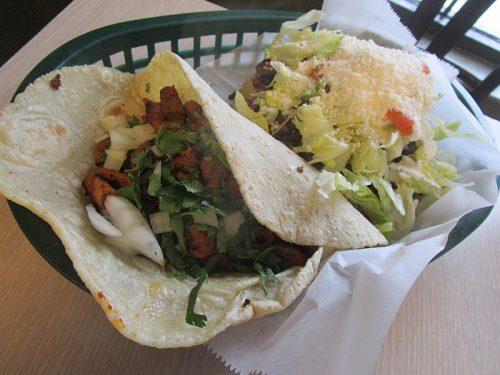
A taco and a sope at Los Gamas

Pollo with mole rojo…
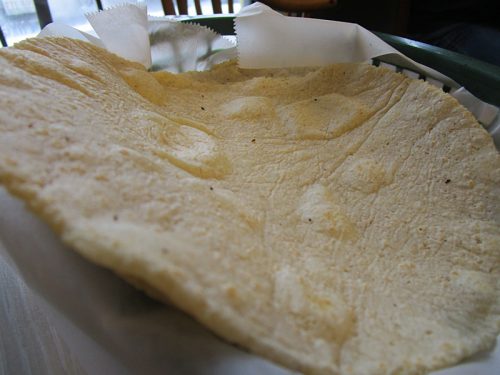
And a side of steaming, chewy tortillas
When you’ve finished your lunch you pay at the other end of the room—this, you can tell, was the old KFC counter—and it’s here that you can see why they built a second small kitchen out of part of the dining room. The real kitchen is occupied, to the extent you can see into it, by a couple of big machines. One of them is a fryer, but not the kind that fries chicken—it’s a long conveyor belt contraption for frying tortillas. You can’t really see much past that, but the smell should have given you the gist of it—back there, they’re making masa, the essential corn-based dough of Mexican cuisine, and from it, tortillas by the thousands.
No less than Rick Bayless has said that Chicago has “the greatest concentration of artisan tortilla factories in the world.” Specifically, the Mexican south side does—there’s El Milagro in Little Village, and Atotonilco on 47th, and El Popocatepetl and Sabinas in Pilsen. There was only one on the north side, Del Rey at Laramie and Grand—until the day in 2009 that the FDA shut them down after a series of violations, one of which made a bunch of schoolkids in Wisconsin sick. A few months later, the owners signed a consent decree getting out of the business entirely.
ALEX GAMA INVITES ME BACK INTO THE KFC kitchen turned tortilla factory, or tortilleria (torti-yair-REEa). There are two steel tubs, one filled with corn kernels slowly cooking in water, the other half-full. The room is dominated, though, by an upright machine that might, somewhere else, be a coffee roaster.
“We add no preservatives. It’s just corn—corn and water and the calcium hydroxide that it has to cook in. That’s all it is,” he explains. “We buy precooked corn from Indiana, and we take it to 170 degrees, and then it goes into the corn grinder.”
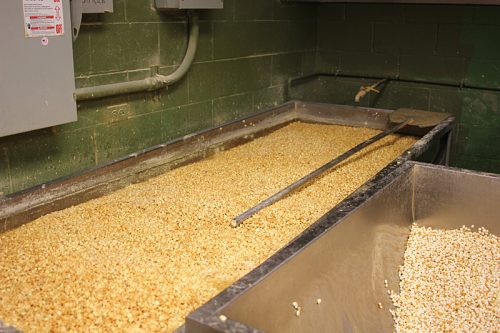
You can’t make true masa from your Quaker Oats can of corn meal. You need lime, specifically calcium hydroxide, first to swell the corn kernels and make them grindable, and then to unlock niacin, which makes the masa a much more valuable source of nutrition—pretty much a complete one, if you’re poor enough that that’s mostly what you eat, as has often been the case through the history of that part of the world.
I ask if I can see the grinder in operation, and Gama calls over one of his employees, Jose Ortiz. “Jose used to work for Del Rey. He’s a very instrumental part of the business,” Gama says.
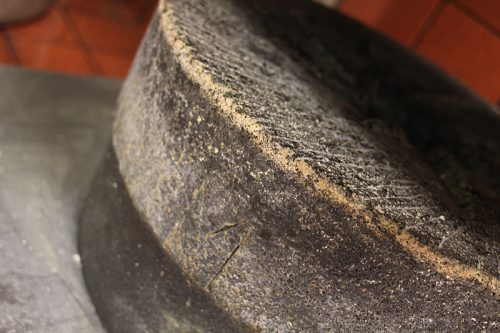
Jose wheels over a cart with two stone disks. The rest of the machine is modern, but in the end stone grinding is pretty much what it was three or four centuries ago, two heavy stones rubbing the corn between them. He fits them into the machine, takes a scoop of the cooked corn, and pours it into the top. The machine comes to life rumbling and vibrating, and as Jose keeps pouring kernels into the hopper, chunks of mixed masa start plopping out into the bin.
“Did you have to import the grinder from Mexico?” I ask.
“No, it was made in California,” he says.
“How much masa do you make in a day?”
“We cook about 2000 pounds every day,” he says. “It depends on the season—when the masa season gets started, roughly in October and all through the holidays—that’s when we cook 6000 pounds a day. In the winter it sells more, because the women want to be in the kitchen. But when it’s hot, they don’t want to be in the kitchen so much, so they don’t buy that much. But it’s steadily going up for us.”
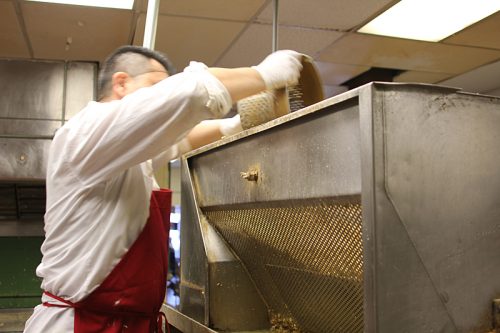

I realize at this point that masa, more than the tortillas, is the crucial end product. In Oaxaca I had seen a neighborhood mill, where you could walk up with a cup full of corn and get your day’s masa needs ground fresh, and it was an important piece of the neighborhood. Tortillas can be trucked from the south side in their paper or plastic packages, but if you don’t have a place where you can buy freshly ground masa to pat out your own tortillas and picalitas at a family celebration, it’s not really your neighborhood, any more than a Frenchman could feel at home in a neighborhood without a baker.
As if to confirm this point, Gama explains how he got into the business. “I saw that there was a need for masa. After Del Rey closed, all the tortilla factories were on the south side.”
We try to integrate every aspect of the masa into the restaurant. I believe that you can’t get any fresher than how we’re doing it for our restaurant.
“Did you have restaurant experience?”
“None,” he says. “I worked for Butler Specialty,” a furniture maker and warehouse on the southeast side. “I’ve never been in a restaurant business, but through my faith, and believing in Christ, I began inquiring about stuff, and we started the business two years ago—this is our third year.”
Making tacos on site was part marketing, part diversification. “The tortilla industry is one of the toughest in Chicago, so we wanted to add something that would help us out as we started, with revenue.” As with most peasant cooking, there’s a way to make use of everything—besides selling masa and tortillas, they take the day old tortillas, fry them and sell them as chips.
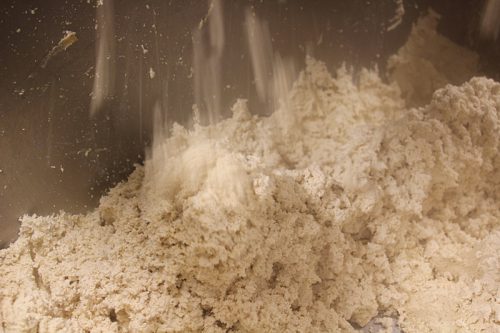
Masa, one end product
“We use our masa and we integrate most of our dishes with what we do here,” he says. “We try to integrate every aspect of the masa into the restaurant. I believe that you can’t get any fresher than how we’re doing it for our restaurant. Most of our advertising has been for our masa and our tortillas, but they come here and it’s an added incentive that they buy a tamal or a taco.”
I ask him what kind of advertising—Mexican radio, perhaps? “In the beginning we did advertise on an AM station,” he says. “But for the most part, what we’ve seen that has been more productive is passing out the flyers in like Catholic churches and stuff like that. And then of course the word of mouth.”
“I think this business was created for God. Being a man of faith, God gave me the idea and showed me things, and glory be to God for the business.”
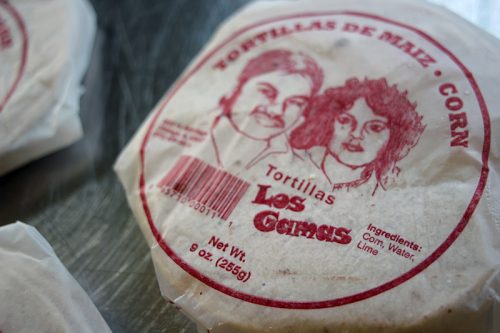
The tortilla packages bear an image of Alex Gama’s parents.
That brings up one more thing I’ve been meaning to ask. “You have those Bible verses on the wall. Why are they in English?”
He laughs and says, “I have no idea! My wife keeps telling me, you should put them in Spanish.”
“It’s the most English in this place,” I say. “Everybody here seems to mainly speak Spanish except you.”
“We like to hire the people in the area, and buy from the area, to keep the money in our community,” he says. “I am going to start doing Spanish versions, but you are right. I don’t know why I just—when we got here in 1979 I was two years old, I was raised here, so for the most part I do everything in English.”

Michael Gebert works hecho a mano as editor of Fooditor.
COVER IMAGE: Alex Gama, owner, and Jose Ortiz at Tortilleria y Taqueria Los Gamas
Latest
Join the Discussion
After you comment, click Post. If you're not already logged in you will be asked to log in or register with Disqus.




